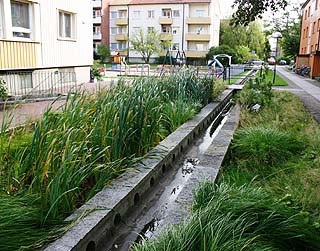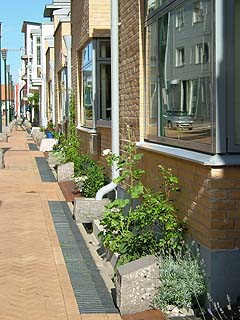|
Subscribe / Renew |
|
|
Contact Us |
|
| ► Subscribe to our Free Weekly Newsletter | |
| home | Welcome, sign in or click here to subscribe. | login |
Architecture & Engineering
| |
January 19, 2005
Capturing the power of rain saves money, improves cities
Special to the Journal

Channels are designed to drain into surrounding wetlands during heavy water flow.
|
Remember when you were eight years old, building a boat of leaves and twigs, and watching it run down a stream?
Whether you thought about it or not, you were watching part of the path a raindrop takes when going from sky to sea.
The average person doesn't think much about stormwater because our cities, as they are designed now, don't give us much chance to notice. Eyebrows are raised only when basements or intersections flood, or when the cost of new pipes runs into the millions.
But today urban designers, landscape architects, civil engineers, artists, public agencies, politicians and even members of the general public are not just paying attention to urban stormwater systems when they fail, they are coming up with ways to reconfigure those systems to address a variety of different issues.
Groups of Seattle developers, designers and public agency representatives have been visiting places that have built "green infrastructure" in Copenhagen, Denmark, and Malma, Sweden.
Rather than running an invisible pipe under the street, strategies are used to mimic the patterns of natural water systems by capturing and slowing water close to where it falls. These strategies not only reduce erosion, replenish groundwater and keep water temperatures low, they also create habitat, make special places and save money. In some cases, developable land is even increased by trading stormwater ponds for swales and trenches that are more flexibly located.

Downspouts draining into an open surface channel provide water for these small home gardens. |
A variety of methods are used to create a "green infrastructure" system. The mosaic of the cityscape was enhanced with new ways of using old standbys such as scuppers, downspouts, trench drains, swales, splash blocks, weirs, gabions and planters.
"Sometimes the best solutions are the simplest," said Liz Dunn, a Seattle developer on the tour. "This goes back to ideas that have been around for awhile. Perhaps the toughest part is just getting the word out about how well these ideas still work. For Seattle, this could be a low-tech triumph in a high-tech town."
To find out more about how this could work in Seattle, the study tours have been targeting some of the best examples worldwide.
An upcoming tour to Berlin will take a look at nature's water cycle being put to work in a downtown area -- Potsdamer Platz. Completed in 1998, this collection of buildings and plazas in the center of the city incorporates water features that gather and re-use rainwater for flushing toilets, irrigation and fire systems.
Ultimately, thinking differently about managing stormwater is based on a macro perspective that considers the whole city as part of the ecosystem.
Seattle has been hard at work on some of these ideas. Today, neighborhoods such as Bitter Lake and High Point are adding alternative means of stormwater management. These techniques leverage the ability of plants and soil to filter water, integrate green spaces within a community and retrofit existing neighborhoods.
For example, on High Point, an ambitious, 130-acre urban redevelopment by the Seattle Housing Authority in West Seattle, Mithun worked with SvR Design and Nakano Associates to link a series of new community parks with a natural drainage system of grass-lined and vegetated swales within the rights-of-way.
High Point's natural drainage system is now a model for achieving aggressive water quality goals within the limitations of a traditional curb, gutter and sidewalk streetscape. Six city of Seattle agencies collaborated on the project, and the process stimulated a larger look at Seattle's drainage systems, including revisions to the city's street improvement design manual. The first phase of the project will be completed in 2006.
Another example of local sustainable storm water techniques is Bitter Lake's bioswales in the Pipers Creek watershed. For a five-block area without sidewalks, driveways were reconfigured and approximately 11 percent of the streets' square footage was turned into swales, which are patches of soil planted with trees and other vegetation.
Referred to as SEA Streets, an acronym for Street Edge Alternative, the swales' 100 evergreens and 1,100 shrubs mimic natural drainage processes that existed before development, and have reduced the amount of stormwater leaving the street by 98 percent.
| Sustainability study tours |
|
International Sustainable Solutions encourages the use of sustainability practices and products by sharing knowledge and creating market opportunities. In 2004, International Sustainable Solutions brought several groups of architects, engineers, developers and others from the Pacific Northwest to Scandinavia to look at advanced urban sustainability projects. Applications are now being accepted for the next Urban Sustainability Study Tour to Sweden and Denmark in May. For information see the ISS Web site at www.i-sustain.com. |
That's great for residential neighborhoods but how does it work downtown? What if we started by setting the goal of capturing about 98 percent of the rainwater within our downtown, the way nature functioned before there was a city? How would we design our infrastructure differently if this were our objective?
Mithun asked this question when it began investigating ways to approach the design of a sustainable neighborhood in the Lloyd Crossing area of Portland. Mithun worked with the Portland Development Commission, community stakeholders and a consultant team that included GreenWorks and civil engineer Tom Puttman, with KPFF.
The results proposed were even more ambitious -- 100 percent of rainwater from the streets are directed to bioswales located at each intersection where plantings and soil hold rainwater and filter it, contributing to the distinct character of the green neighborhood.
Deb Guenther is a landscape architect with Mithun. She toured Scandinavian cities last year as part of an International Sustainable Solutions study tour of sustainable neighborhoods.


